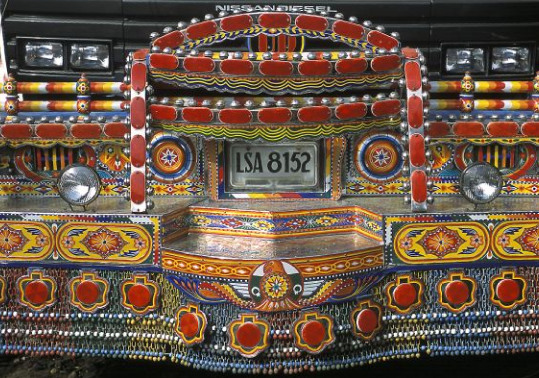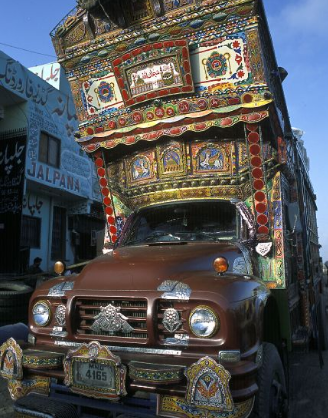![]()
![]()
She may well have been the best leader available. With a military dictator and a corrupt businessman as the alternatives, Benazir Bhutto, with her western admirers and her feudal followers, was clearly a front-runner. How she died will probably remain a mystery, but she was playing the game of death, and it was unlikely she would win every time.
It is difficult to write about people who have just died. Many are grief stricken at the untimely death of the former prime minister. Even her critics are shocked by the way she was hunted down. An insensitive piece would aggravate their pain, and one doesn’t generally speak ill of the dead. I remember as a child asking my mother “Amma. Do bad people never die?” A man not known for his strength of character had died, and newspaper reports had described him as an honest social worker. I am no longer of the age to get away with such questions. But even for those who have loved Benazir, I believe the questions need to be asked if this cycle is to ever stop.
It was 1995. They were troubled times in Pakistan. I had gone over to Karachi on the invitation of my architect friend Shahid Abdulla. There were no telephone booths at Karachi airport, or anywhere else in the city. The government was worried the MQM would use them for their communication. Sindh was at war with itself.
Shahid wanted me to run a photography workshop at the Indus Valley School of Architecture and Design that he was involved in. Those were the days when we had time for long conversations. We talked of many things. The gun-toting security men outside every big house in Karachi. Shahid’s meeting with Zulfiqar Ali Bhutto. His memories of Benazir. But the conversation would often veer to a person we both admired. Abdus Sattar Edhi, the humanitarian who had set up an unparalleled ambulance service all over Pakistan.
On the morning of the 10th October, I went over to see the man. He had an easy charm that came from living a simple life and having little to hide. He sat on his wire mesh bed, talking of how things started. We were regularly interrupted by people coming in with requests, and Edhi responding to minor crises. Then we heard about Fahim Commando the MQM leader, having been killed. Fahim and his comrades had apparently been caught in an ambush and all four had died. They had been in police custody, but the police had all escaped and not one of them had been injured. Edhi was not judgmental. Fahim was another man who needed a decent burial. As I watched him bathe the slain MQM leader, I could see the burn marks on the bullet holes on the commando’s body.
 Abdus Sattar Edhi, bathing Fahim Commando. Karachi. Pakistan. 10th October 1995. ? Shahidul Alam/Drik/Majority World
Abdus Sattar Edhi, bathing Fahim Commando. Karachi. Pakistan. 10th October 1995. ? Shahidul Alam/Drik/Majority World
The extra-judicial killings during Benazir’s rule are well documented. The fact that no investigation was done when her brother Mir Murtaza was killed outside Bilawal House, the family home, fueled the commonly held belief that her husband Asif Zardari had arranged the killing. Even Edhi’s ambulances had not been allowed access. Not until Murtaza had bled to death. Anyone who witnessed the murder was arrested; one witness died in prison. Benazir was then prime minister.
Murtaza had been vocal against the corruption of Zardari. Benazir defended her husband stoically throughout. Despite the Swiss bank accounts, she assured people that he would be seen as the Nelson Mandela of Pakistan. With Zardari now tipped as the new chief of PPP, Pakistan’s Mandela and his Swiss bank accounts might well be the new force. Whether Pakistanis will see this polo-playing businessman as the saviour of the day remains to be seen.
Supported by the US, Zulfiqar Ali Bhutto had been largely responsible for the break up of Pakistan and the genocide in Bangladesh. The current string pulling by the US has hardly made Pakistan a safer place. The western support of militarisation in Bangladesh and the growing importance of Jamaat is an all too familiar feeling. If Pakistan is an omen, it is a sinister one.
Perhaps Mrs. Packletide would have known how the former prime minister of this nuclear nation died. But the government’s attempts to cover-up will do little to quell the conspiracy theories. Like the Bhutto family, the military too have burned a lot of bridges in getting to where they are. There are too many skeletons in their closet. There is no going back, and no price too high.
Tag: Pakistan
I hear the screams
![]()
Even after years of playing Pied Piper with a camera, I am still taken aback by children insisting on being photographed. It was September 1988, and we had had the worst floods in a century. These people at Gaforgaon hadn’t eaten for three days. A torn saree strung across the beams of an abandoned warehouse created the only semblance of a shelter. Their homes had been washed away. Family members had died. Yet the children had surrounded me. They wanted a picture.
It was dark in that damp deserted warehouse, but the broken walls let in wonderful monsoon light, and they jostled for position near the opening. It was as I was pressing the shutter that I realised that the boy in the middle was blind. He had pushed himself into the centre, and though he wasn’t tall he stood straight with a beaming smile.
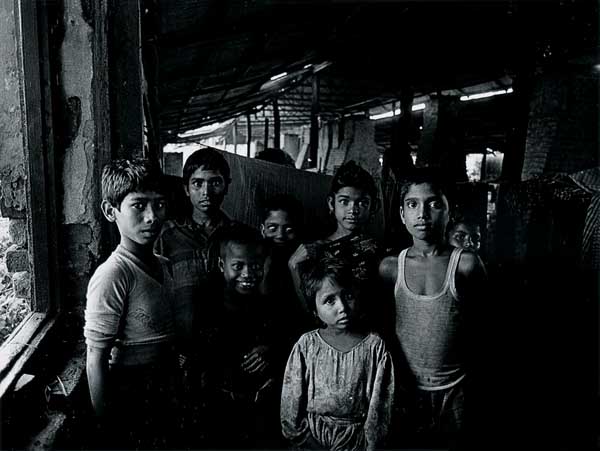
Shahidul Alam/Drik/CARE
Clip on story of the blind child, from keynote presentation on citizen journalism at 50th Anniversary of World Press Photo in Amsterdam.
I’ve never seen the boy again, and today I question the fact that I do not know his name. But he has never left my thoughts and often I have wondered why it was so important for that blind boy to be photographed.
It’s happened elsewhere, in boat crossings at the river bank. In paddy fields heavy with grain, in busy market places. A shangbadik (literally a journalist, but in practice any person with a half decent camera) was hugely in demand. They refused to take the fare from me at the ferry ghat. Opened up their hearts and told me their most personal stories. Confided their secrets, shared their hopes. Never having deserved such treatment it has taken a while for me the photographer, to work out why being photographed meant so much to that blind child.
The stakeholders of Bangladeshi newspapers are the urban elite. Consequently stories from the village are about the exotic and the grotesque. Village people exist only as numbers, generally when plagued by some disaster and only when figures are substantial. A photograph in a newspaper, regardless of how token the gesture, is the only time a villager exists as a person. A picture on a printed page would have lifted that blind boy from his anonymity. That humbling thought stays with me whenever I am feted as a shangbadik in some small village. I receive their gift of trust gently, careful not to break the delicate contents.
It was as a photographer of children that I had begun my career. It was way before 9/11 and one could make appointments with strangers and go to their homes. I took happy pictures of kids, and parents loved them. It was easy money, except when I would photograph the children of poor parents. They loved the pictures but couldn’t afford to pay, so I would quietly leave the pictures behind and pay the studio out of my pocket. Back in Bangladesh, the only way I could make money was as a corporate photographer, but something else was happening. We were in the streets, trying to bring down a general who had usurped power. I didn’t know it then, but I was becoming a documentary photographer. Suddenly taking pictures of children meant more than smiling kids on sheepskin rugs.
As the pressure against the general mounted, I photographed children who joined the processions. The night he stepped down, I photographed a little girl with a bouquet of flowers. She was out with her dad in the middle of the night, celebrating the advent of democracy.
I am back in Kashmir eight months after I had been here photographing the advent of winter. The valleys of this fertile land are green with new crops, 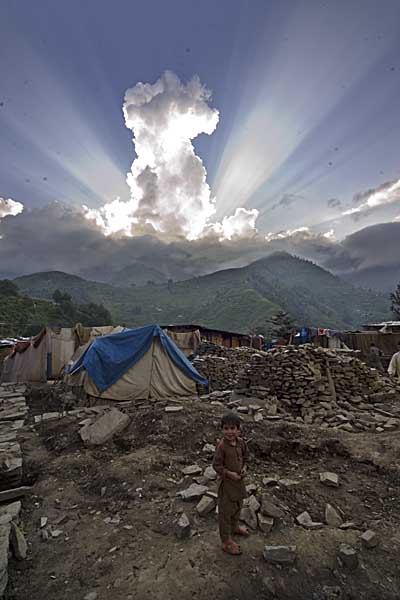
Shahidul Alam/Drik/CONCERN
but many of the homes are still to be rebuilt. As I walked through the rubble, the kids again wanted to be photographed.
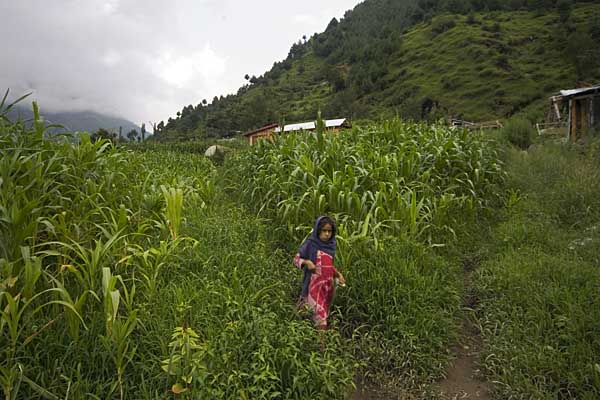
Shahidul Alam/Drik/CONCERN
Najma came running, her bright red dress popping out of the green maize fields.Unsure at first, she smiled when I told her she had the same name as my sister.
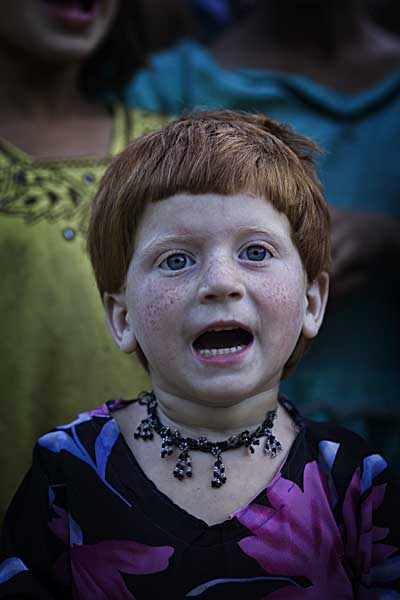
Shahidul Alam/Drik/CONCERN
Zaheera, a cute girl with freckles, gathered her friends and sang me nursery songs. But my thoughts are far away. Despite the laughter and the nursery songs very different sounds enter my consciousness. I remember the children screaming on the night of the 25th March 1971, when I watched in helpless anger as the Pakistani soldiers shot the children trying to escape their flame throwers. The US had sent their seventh fleet to the Bay of Bengal, in support of the genocide. Today, as I remember the Palestinians and the Lebanese that the world is knowingly ignoring, I can hear the bombs raining down on Halba, El Hermel, Tripoli, Baalbeck, Batroun, Jbeil, Jounieh, Zahelh, Beirut, Rachaiya, Saida, Hasbaiya, Nabatiyeh, Marjaayoun,Tyr, Jbeil, Bint Chiyah, Ghaziyeh and Ansar and I hear the screams of the children. Piercing, wailing, angry, helpless, frightened screams.
News filters through of the children killed in the latest bombing. The photographs have kept coming in, horrific, sad, and disturbing. Mutilated bodies, dismembered children, people charred to ashes. But none as vulgar as those of Israeli children signing the rockets. Death warrants for children they’ve never known.
I remember my blind boy in Gaforgaon. The Lebanese and the Palestenians are also people without names. Their pain does not count. Their misery irrelevant, their anger ignored. Sitting in far away lands, immersed in rhetoric of their choosing, conjuring phantom fears necessary to keep them in power, hypocritical superpowers fail to acknowledge the evil of occupation. The ‘measured response’ to a people’s struggle for freedom will never in their reckoning allow a Lebanese or a Palestinian to be a person.
When greed becomes the only determining factor in world politics. When the demand for power, and oil and land overshadows the need for other people’s survival, I wonder if those screams can be heard. I wonder if those Israeli children will grow up remembering their siblings they condemned. I wonder if through all those screams the war mongers will still be asking “why do they hate us”?
11th August
Siran Valley, North West Frontier Province, Pakistan
Masterpieces To Go
Another non-terrorist Pakistani story.
Under the shade of a colossal banyan tree, Karachi truck painter Haider Ali, 22, is putting the finishing touches on his latest creation: a side-panel mural of Hercules subduing a lion, rendered in iridescent, undiluted hues of purple, yellow, red and green. His 10-year-old nephew, Fareed Khalid, applies a preparatory undercoat of white paint to the taj, the wooden prow that juts above the truck?s cab like a crown. Like Ali?s father, who first put a brush into his son?s hand at age eight, Haider is carrying on a master-apprentice tradition with Fareed, who spends his afternoons in the painter?s workshop after mornings in school.
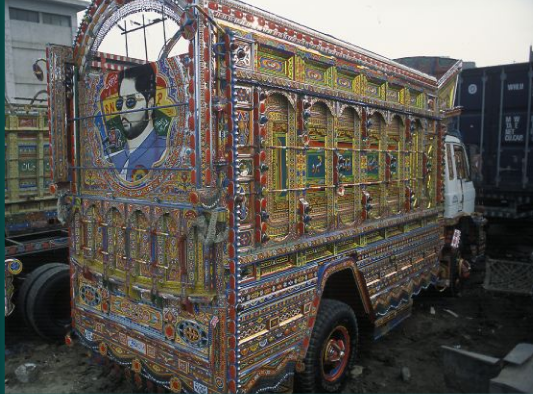
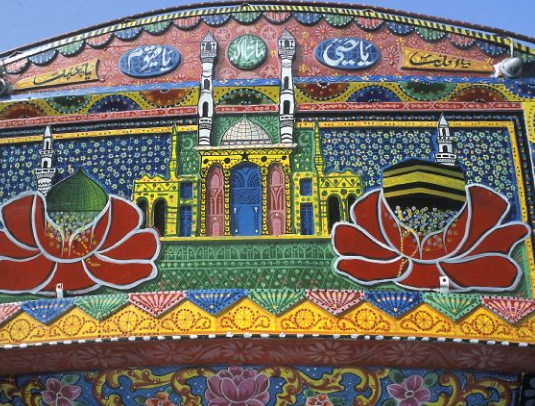
The War We Forgot
Subscribe to ShahidulNews
![]()
Iqbal had asked me when we first met. “Bhaiya, where are Barkat and Salaam’s graves?” I didn’t know. He was 10, I was 39. As a 15 year old in 1971, I had felt the warm flush of victory as I held a Pakistani Light Machine Gun in my hand. I hadn’t really won it in battle, but only recovered it from a burning military truck. But the joy was just as much. That was the time when a rickshaw wallah had refused to take my fare, because he had heard me greet a friend with ‘Joy Bangla’ (freedom for Bengal, the 1971 slogan symbolizing freedom from Pakistani rule). Things had changed, and the promise of our own land had slowly been eroded by politicians and military rulers who had lived off our dreams. Each time we became skeptical, each time we sniffed that something other than ‘Shonar Bangla (Golden Bengal)’ was in their minds, they led us on with vitriolic rhetoric. Eventually, as on that day in 1994, I too had forgotten. I didn’t know where Salaam and Barkat’s graves were. I had never heard of Dhirendranath Datta. More importantly, I didn’t care. But Iqbal did. Born long after Salaam and Barkat’s bodies had merged with the soil, Iqbal only knew of this great battle that we had fought. Though the heroes had changed depending upon who ruled the country at any particular time. Salaam and Barkat were beyond dispute. They were not a threat to anyone. They didn’t apply for a trade license, or bid for a government tender. It was safe for the history books to remember them. Remembering Hindus or women was a bit more problematic.
My search for these other heroes, the ones with cameras, began in 1994. After Iqbal reminded me that I had forgotten. It was in the Paris office of Sipa that Goksin Sipahioglou, excited at my presence ran down the stairs and brought back with him an armload of slide folders. It took a while for it to sink in. These were the first colour photographs of the Muktijudhdho that I had ever seen. We had heard that some of these photographs had been published. But our only source of news at that time was Shadhin Bangla Radio. It talked of the glory of our freedom fighters, of how they were fearless against enormous odds. Of their glory in battle. M R Akhtar Mukul in ‘Chorompotro’ was the one voice we longed for. We chuckled as he talked of the plight of the Pakistanis. His wry but animated voice, muffled by the blanket we hid under, and barely audible in the turned down volume of the transistor radio, gave us hope, and kept us going through the dark nine months.
It was Abbas’ photographs that Goksin had brought for me. Later that month, in the back garden of a house in Arle, I met Don McCullin. Don was excited about the show I wanted to do, and unhesitatingly agreed to give us pictures. I found Abbas, at a beach near Manila, quite by accident. Both of us had been following the golden late afternoon light in a summer evening in Manila beach. Abbas too was excited. He wanted to be part of the show. Michele Stephenson and I had been in the same jury of World Press Photo on two occasions, and I had plenty of time to tell her about my plans. She invited me to New York and arranged for me to go through the archives of her magazine, Time. It was in the basement of the Time Life Building in the Avenue of the Americas, that I came across the daily bulletins that the reporters had sent in.
Memories flooded through my mind as I remembered those harrowing days and nights. I remembered the screams of people being burned alive as the flame throwers belched fire at the Holiday office near the Hotel Intercontinental.
Most of the people who died were the people who slept in the streets and the slum dwellers around the newspaper office. Those who chose to escape the fire ran into a hail of machinegun bullets. My father, mother, Babu bhai and I, watched quietly from our verandah in Nasheman on New Elephant Road. My dad had suffered from Hindu bhodrolok prejudice in the pre-partition days, and had never supported the break-up of Pakistan. And we would have great fights in the home, the younger ones wanting independence, Dad’s generation feeling things could be patched up. That was the night Dad said it was over. No longer could we ever be one Pakistan.
I excitedly went through the reams of paper. Each scrap of news had a meaning for me. I could relate to these news bulletins. I remembered the horror of those nights. As I thumbed through a tattered red diary, I noticed the skimpy notes of a photojournalist as he traveled through Jessore. I remembered Alan Ginsberg’s poem. It was David Burnett’s diary. Several years later as David and I met in Amsterdam in yet another World Press Jury, I told him where his diary was. In Kuala Lumpur, Dubai, Delhi, and so many other cities have I picked up the scraps of evidence that would help me piece this jigsaw together.
It was in Paris that I spoke excitedly of my plans to Robert Pledge, the president of Contact Press Images. Robert shared my enthusiasm for the project, but I harried him with my feverish frenzy. We couldn’t wait, we had to do it now. That now has taken over six years. But in these years we have made the most amazing discoveries. The stories, the images, the people we have come across, make up the life of this exhibition. It is the war veterans, the men and the women in the villages of Bangladesh, who fought the war, the forgotten heroes with their untold stories, the men and women who were killed and maimed, the women who were raped that this show is dedicated to. It is not a nostalgic trip for us to romanticize upon. It is for Iqbal and his friends to know that Barkat and Salaam, were more than simply names in history books.
Shahidul Alam
November 2000. Dhaka

